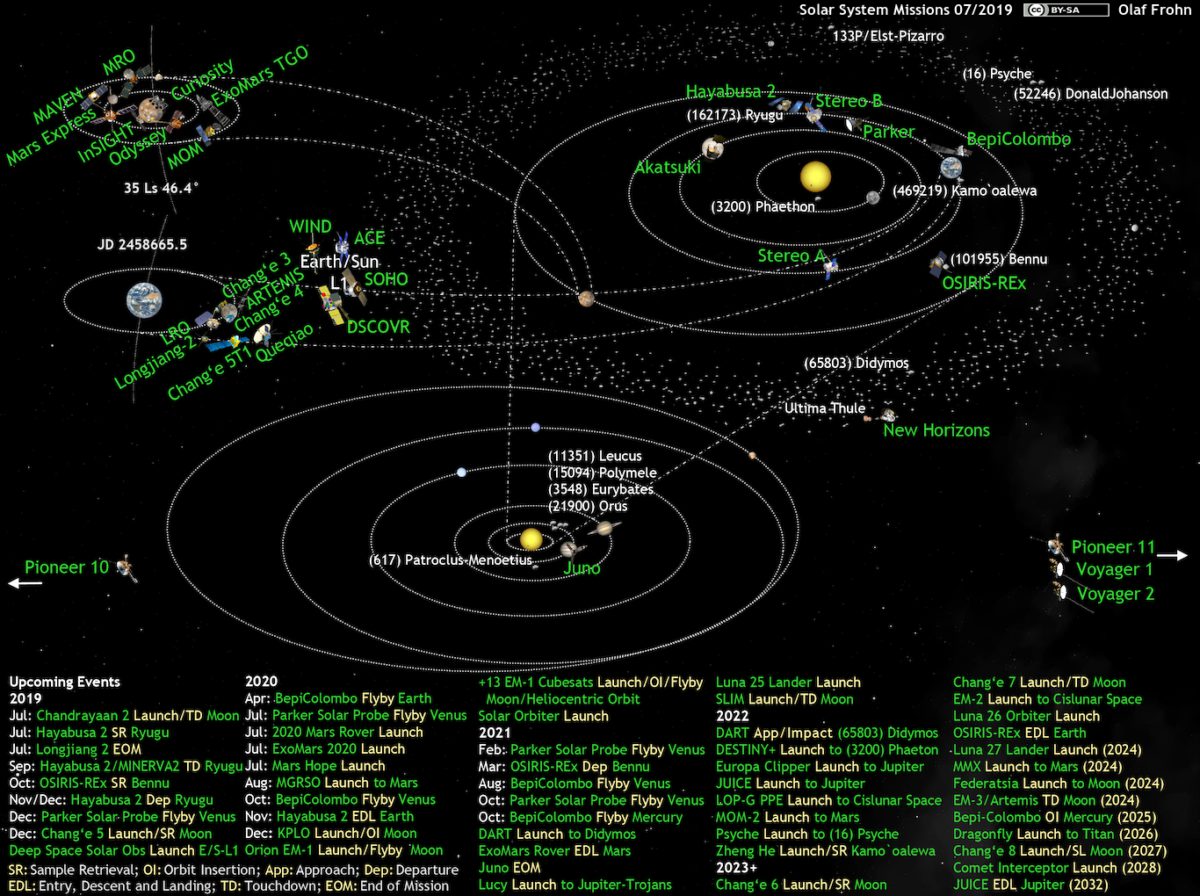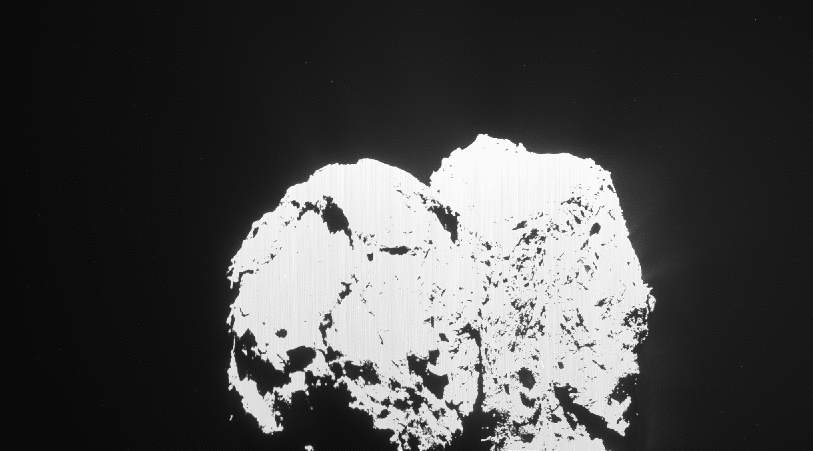Emily Lakdawalla • Aug 31, 2016
What's up in the solar system, September 2016 edition: OSIRIS-REx launches, Rosetta ends
The month of September begins with an annular solar eclipse visible from much of Africa on September 1, with the path of totality crossing Gabon, Congo, DRC, Tanzania, Mozambique, and Madagascar. Mid-month (on or after September 8), we'll see OSIRIS-REx launch into a two-year cruise toward a rendezvous with asteroid Bennu. But you win some and you lose some: September will close, sadly, with the end of one of our great flagship planetary exploration missions. Rosetta will be brought down onto the surface of comet Churyumov-Gerasimenko on September 30, after which it will be unable to communicate with Earth, and the 12-year mission will be over. We'll still have about 19 spacecraft performing routine science operations (Akatsuki, Lunar Reconnaissance Orbiter, possibly Chang'e 3 and Chang'e 5 T1, ARTEMIS, Odyssey, Opportunity, Mars Express, Mars Reconnaissance Orbiter, Curiosity, Mars Orbiter Mission, MAVEN, Dawn, Juno, Cassini, New Horizons, and the Voyagers), while Hayabusa2 and ExoMars Trace Gas Orbiter are cruising toward their destinations.
Here's Olaf Frohn's chart of active space missions.

Earth Launches and Landings (contributed by Jason Davis)
Astronauts Jeff Williams and Kate Rubins kick off September in style Thursday, clambering out of an International Space Station airlock for a six-and-a-half hour maintenance spacewalk. If time allows, they'll tackle some other odd jobs, including a photo survey of Alpha Magnetic Spectrometer. Williams, along with cosmonauts Oleg Skripochka and Alexey Ovchinin, return home in their Soyuz TMA-20M spacecraft on Sept. 6. Two weeks later on Sept. 23, a new Expedition 48 crew trio blasts off from Baikonur: NASA's Robert Kimbrough, and Russia's Andrei Borisenko and Sergey Ryzhikov.
The only other possible ISS traffic this month would be an Orbital ATK Cygnus cargo freighter, which would launch when the company's Antares rocket returns to flight. NASA's last update predicted a launch sometime in the second half of September.
Other American missions this month include two Atlas V flights by United Launch Alliance: OSIRIS-REx on Sept. 8, and DigitalGlobe's Worldview 4 commercial Earth observation satellite on Sept. 15. The latter will fly from Vandenberg Air Force Base in California. SpaceX's next scheduled launch is the Amos-6 communications satellite, but no date has been announced.
In international launch news, China may launch its Tiangong 2 small-scale space station this month, according to multiple news sources. Arianespace is blasting a pair of Earth observation satellites into orbit on Sept. 15 using the spry, fun-to-watch Vega rocket. Finally, according to Spaceflight Now's launch schedule, India could have up to two weather and climate satellite missions on the launch pad this month.
Inner Solar System
I don't see any news on Akatsuki, but it's always worth checking in on the mission's Twitter feed and website with help from an online translation tool.
Earth's Neighborhood
This month, new moon is on September 1 (during which there will be an annular solar eclipse crossing much of Africa) and full moon is on September 16, during which there will be a penumbral lunar eclipse.
Lunar Reconnaissance Orbiter's mission has been renewed for two years, through October 2018. The latest extended mission is titled the "Cornerstone Mission" and will involve teaching the orbiter some new tricks using "a combination of new operations modes, orbit evolution, and collaborative measurements," according to the report from NASA's senior review of operating missions. Honestly, I think that photos like the oblique view of Orientale posted below are reason enough to keep Lunar Reconnaissance Orbiting -- but once I'm there for the photos, I'll stay for the science!

I don't have an updates on ARTEMIS since last month beyond what I wrote in February, or on Chang'e 3 and Yutu since the confusing flurry of reports about the rover maybe being dead, or not, and I haven't had any information on the status of Chang'e 5 T1 for a long time. Amateur radio operators who listen for Chang'e 3 signals haven't heard anything from it or Yutu for a while.
OSIRIS-REX is very close to launch, which is still planned for September 8, 2016 at 23:05 UTC (16:05 PDT). The Centaur upper stage was lifted atop the Atlas rocket on August 11, and the single extra rocket booster was attached to the side of the Atlas V on August 23. On August 24, the spacecraft was encapsulated inside its protective fairing. It was lifted atop the rocket August 29. Check the NASA Kennedy Flickr page for lots of photos. Here's a timeline of what to expect on launch day.
Near-Earth Asteroids
Hayabusa2 is now 110 million kilometers from Earth and 58 million kilometers from Ryugu. The Ryugu observation campaign, inviting amateur observers to attempt to image Ryugu, has paid off with a few observations, including this one made by high school students working in a summer program at Bisei Spaceguard Centre, seeing Ryugu at 19th magnitude! (That's very faint.) I stabilized the animation a bit. Stop for a moment and contemplate what it means that we can send a spacecraft to go visit this teeny tiny little point of light, which is now invisible from Earth, and show us its nature.

On the Way to Mars
ExoMars Trace Gas Orbiter is getting very close to Mars. Following its large deep-space burn at the end of July, it completed a smaller clean-up maneuver on August 11. Tracking of the spacecraft following the July burn showed that the spacecraft performed to within 5 millimeters per second of its desired 334.176 meter-per-second burn, a difference of only 0.002% -- an exceptionally accurate performance. They still needed the clean-up burn because longer burns yield more uncertainty in burn performance, so they do a big maneuver to get most of the way to their desired trajectory, assess the performance, and then do a much shorter burn afterward to fine-tune it. Orbit insertion will be on October 19; Schiaparelli will land on the same day. Here's an overview of what to expect on arrival day. Meanwhile, the Opportunity rover team is still working on plans to attempt to photograph the bright pixel of Schiaparelli as it lands, but the rover is on the move and it's possible that the Endeavour crater rim will hide Schiaparelli's entry from Opportunity's view. Also, ESA posted a story on the Schiaparelli landing site.
Mars
It's now a couple of months past equinox, heading toward summer in the southern hemisphere landing sites of the two Mars rovers. Mars will be at perihelion on October 29.
Mars Odyssey was in the news last month as its THEMIS instrument was used, unsuccessfully, to search for thermal evidence of water in seasonal recurring slope lineae within Valles Marineris, in contradiction to last year's announcement that they were likely the product of trace amounts of seasonal briny water. Personally, I think we're not going to understand those features until we can visit them up close, and watch them change over time. Odyssey's 15th Mars arrival anniversary is coming up on October 24. Fun recent image releases at the THEMIS website have included a couple looking at the defrosting south polar cap (see here and here) and several nice ones of early morning fog in canyon floors (see here and here).
There's not much news from Mars Express, but the continued flow of images from the Mars Webcam show that the spacecraft is actively gathering science data. Most of the most recent images show a crescent Mars with the south pole at the center; with equinox just past, there's still a lot of frost on the ground, and Mars Express is getting a great view of seasonal change at the pole.

Mars Reconnaissance Orbiter reports quite a bit of local dust and water ice cloud activity across the planet in the most recent MARCI weather report, but still clear skies over both rovers. For their two-year mission extension (the mission's fourth extension), they proposed to work on "determining Mars habitability, assessing present Mars volatile inventories, monitoring surface changes (particularly those involving water), and monitoring present atmosphere and polar processes."
MAVEN completed its sixth deep-dip campaign on August 4. August 8 marked its one-Mars-year anniversary in orbit. MAVEN's extended mission will take it through two more Earth years -- another Mars year -- and will include many more deep-dip campaigns as well as lots of cooperative science with other Mars missions. For further reading, you might enjoy this blog entry by team member Rob Lillis, describing why it's hard to figure out Mars' atmospheric loss.
It's now Opportunity sol 4480. The rover spent a few weeks studying some interesting grooves in the valley slope but has wrapped up work there. Now it is making its way south, below (to the east of) the Marathon Valley outcrops it has been studying for most of a year. Power has deteriorated a bit, down to 682 watt-hours in the most recent update, due to more dust in the atmosphere. We're not at dust storm season yet so hopefully it will pass.
On the other side of Mars, Curiosity has made it most of the way south through the Murray buttes. According to the most recent Astrogeology blog, they will be stopping to drill again soon. Don't miss Seán Doran's awesome visualizations of the Murray buttes with astronaut figures dropped in for scale! After drilling and exiting the buttes, Curiosity will drive another kilometer south to cross an interdune region of bedrock, then there is another kilometer-plus of dune-threading before it will arrive at the next change in bedrock type. It looks like they plan to drill fairly regularly along the way.
A few articles on Mars Orbiter Mission appeared in Indian news media last month. Mars Orbiter Mission will see its second anniversary in Mars orbit on September 24, and all five instruments seem to still be functioning. A respectable total of 30 kilograms of fuel remains aboard, according to an article in the Indian Express. The same article says they are now planning to cope with an anticipated 7- to 8-hour eclipse in January, something that the spacecraft can't tolerate well because it has insufficient battery power. They plan to do a trajectory correction maneuver that will shorten the duration of the eclipse.
Beyond Mars
Only one month remains for the Rosetta mission; the spacecraft has begun spiraling its orbit lower and lower. The most recent elliptical orbit dived to within 4.4 kilometers of the surface! They released an awesome animation (below) of an outburst from the comet recorded in February, along with a lengthy science story describing all the different instruments' perspectives on the outburst. It was lucky that all the instruments happened to be on at the time -- but you make that kind of luck by having a mission that lasts as long as Rosetta has. It's going to be very sad to see this mission end. Check here for the latest NavCam image releases and here for the OSIRIS image of the day, and watch this site to see Rosetta's current position with respect to the comet. I plan to attend the end-of-mission event at the European Space Operations Centre at the end of this month, and pay my respects to this great mission.

The Dawn team announced this morning that the spacecraft is moving to a higher orbit, going from 385 to 1460 kilometers altitude, which will permit it to conserve its precious remaining hydrazine fuel and prolong the life of the mission. The new orbit will allow Dawn to view Ceres under different lighting conditions than its previous orbital phase at a similar altitude. It will take some time to transition from lower to higher orbit, time that the team will use to plan the extended-mission science. Earlier this month, there was an update on the gravity results from the mission. Gravity studies have confirmed that Ceres is in hydrostatic equilibrium (meaning, its shape represents a balance between its internal composition and flattening from spinning) and that it's differentiated into an icier outer layer and a rockier inner layer, but that "the divisions between different layers are less pronounced inside Ceres than the moon and other planets in our solar system." As always, check the Photojournal for the latest images!
After successfully completing its first close pass by Jupiter, Juno is downlinking data; we should be seeing new JunoCam images any day now. JunoCam is going to continue taking Marble Movie photos through October 18, with a one-week interruption from September 23-30. That's because Jupiter is going to pass behind the Sun as seen from Earth on September 26. Solar conjunction has two effects on Juno: one, it's hard to command a spacecraft through the Sun's radio noise, so the spacecraft will be doing limited operations. Two, all this month and next, it won't be possible to get good photographs of Jupiter's cloud features from Earth, so we won't really know where to target JunoCam images well until we get the next bunch of JunoCam images back after the third perijove passage, on November 2.

Cassini begins its Rev 242 on September 6. September 11 will mark one year until the mission ends. Cassini is still pumping its orbit to higher and higher orbits with successive Titan flybys. Cassini begins rev 242 with an inclination of 54 degrees. The orbital period is really short right now; Cassini circles Saturn in only 12 days, and its apoapsis is not very far out, just around Hyperion's orbit. The next Titan flyby is on August 27, at an altitude of 1737 kilometers. That flyby will make its orbital inclination higher (58 degrees) and period shorter (only 9 days!) It's beginning to feel like Cassini's circling the drain; these shorter and shorter orbits are all part of the process of getting it set up to make a big leap on November 29, taking its periapsis from its current position outside the ring system to a location just outside the F ring. (That is, just outside the main ring system, but inside the broader, fainter G and E rings.)
New Horizons is now 36.3 AU from the Sun and 3.3 AU beyond Pluto. They're busily returning data from distant observations of other Kuiper belt objects, like the Ceres-sized Quaoar, which New Horizons imaged on multiple occasions in July. This month's team blog is a reflection by Hal Weaver on the long journey. My favorite bit of news about New Horizons this month is that the first data release to the Planetary Data System has now been incorporated into the wonderful OPUS search tool, making it easy to browse and download interesting data.
Finally, the Voyagers are still going, going, going. Voyager 1 is at 136.0 AU from the Sun, and Voyager 2 is at 112.1 AU.
The Time is Now.
As a Planetary Defender, you’re part of our mission to decrease the risk of Earth being hit by an asteroid or comet.
Donate Today

 Explore Worlds
Explore Worlds Find Life
Find Life Defend Earth
Defend Earth

